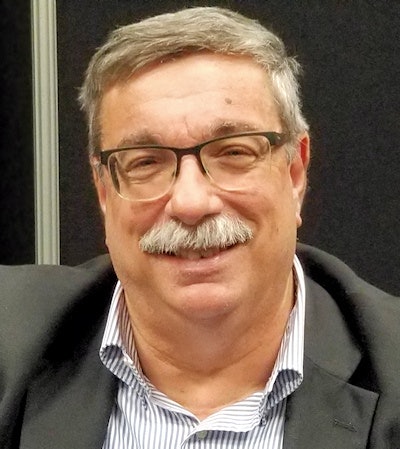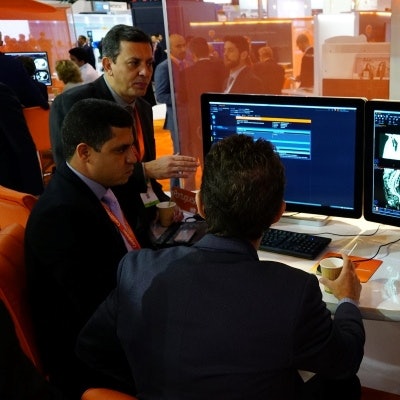
The world as we once knew it ceased to exist in mid-March 2020. Words like "social distancing" started showing up in the lexicon, face masks became mandatory, and in-person meetings were replaced by videoconferencing.
 Mike Cannavo.
Mike Cannavo.Trade show after trade show was canceled and have slowly but surely been replaced by virtual meetings. This includes this year's RSNA 2020 conference. Navigating 450,000 sq ft of exhibit space by foot has been replaced by a computer, monitor, mouse, and keyboard.
Will virtual RSNA work? Everyone hopes so, but whether it will or not remains to be seen.
No one really knows just how the virtual show will work or even if it will be accepted by the masses. RSNA registration is on par with last year, so people are willing to give it a try -- but if they stay and how long they stay online remains to be seen.
Like most shows that are going fully virtual this year, there is a lot of winging it going on. This is true both for those who are putting the show on and those who will be attending it.
 Vendors may face challenges showing their products at a virtual RSNA.
Vendors may face challenges showing their products at a virtual RSNA.The challenges of dealing with a virtual show are many. Determining just the right amount of bandwidth, addressing network security concerns (especially if accessing the show from a hospital computer over the hospital's network), asking the right questions, getting the right answers, and a host of other issues remain to be tested. You can also no longer just drop in on a "demo in progress" either, although vendors used to look at that as both a blessing and a curse.
The inability at a virtual meeting to reach out physically, see products in person, and interact with sales representatives often have been considered negatives. But there are a few positives to the virtual show. The first may initially seem like a detriment: The virtual show will have a limited number of vendors compared with a conventional RSNA meeting.
As of press time, 239 vendors were registered for RSNA 2020, compared with 735 exhibitors at RSNA 2019 at McCormick Place in Chicago. Trying to see even a few dozen vendors or modalities in two days that an attendee has on average to do the show in person has always been a challenge.
 Odds are you won't miss this scene from past RSNA shows.
Odds are you won't miss this scene from past RSNA shows.Having fewer vendors to evaluate virtually allows attendees to spend more time in the virtual booths interacting with the company's personnel. It also allows an attendee to do a more in-depth evaluation of the products and services.
RSNA 2020 has longer hours than in years past -- from 8 a.m. to 6 p.m. (Central time) daily versus 10 a.m. to 5 p.m. The show is also allowing an extra three hours from 6 p.m.-9 p.m. for industry presentations as well.
Larger vendors with a global presence may also be staffing their sites 24/7, which would allow access even beyond extended hours. This is a plus for radiologists and others who can't participate during regular show hours but still want to review what their colleagues have seen over the course of the meeting. It also allows other hospital personnel beyond radiology to have input into product purchasing, whereas before, the decision was pretty much relegated to certain representatives of the group or facility.
The RSNA 2020 exhibition also lasts three days longer -- seven days versus the usual four and a half, from Sunday, November 29, through Saturday, December 5.
Lastly, the RSNA will also be extending the exhibitor profile page after the live meeting ends and will make exhibitor pages available on demand through April 30, 2021.
With those pluses, what are the challenges? Being able to physically see or touch the devices gives you an idea of the scale and representation of the required interaction/interface that a physical review provides -- a feeling that's missing at a virtual meeting. With image processing software, the image quality you see also is limited to the image quality you have on the display you are watching it through, what the vendor provides, or both.
You also may be limited at the virtual meeting to the types and number of images provided depending on the bandwidth that the RSNA has available. Downloading a 1,000-slice CT study or several 10-MB digital breast tomosynthesis images from a local server is one thing -- doing it over the internet, especially over hospital bandwidth where you may be throttled back, is another.
Processing the study yourself, on your own workstation, so you can also get a feel for the software operation is also just about impossible for almost everything. Of course, with travel pretty much limited due to COVID-19 travel restrictions, virtual demos are about all you will ever get to see anyway for quite a while.
So how do you get ready for RSNA 2020? Preshow preparation is key especially this year.
Before we even talk about how to identify the vendors you want to see in detail, you need to determine the location from which you plan on accessing the show. If you are doing this from the hospital, it might be to your benefit to make sure the information technology department knows what you are doing and your bandwidth requirements. Doing it from home you usually don't have those issues as most home internet connections are at least 100 Mb these days, at least in major metropolitan markets.
That said, if you are sharing bandwidth with several other departments within the hospital and plan on being online continuously all day long you might want to ensure that it doesn't negatively impact the hospital operations. The hospital might also have specific security requirements that need to be met as well, especially logging into an IP address they are not aware of or have previously qualified. Rule of thumb here -- assume nothing and get it cleared.
Once you are set you can start researching vendors and the technology. We will use AI as an example because it has, and continues to generate, a high amount of interest.
 Over 120 vendors exhibited at the AI Showcase at RSNA 2019.
Over 120 vendors exhibited at the AI Showcase at RSNA 2019.The AI Showcase at RSNA 2019 had 123 vendors, nearly double the number of vendors it had in 2018 and triple that of the year before. Even with that high a number, there were still AI vendors that chose to not exhibit at the show in 2019.
This year there is much less than half the number of AI vendors as in 2019, with almost all of that change directly attributable to the format change.
Doing due diligence requires that you examine all the available options to see which one or ones will work for you. That means going beyond the RSNA alone.
Many people make the mistake of thinking that exhibiting at the RSNA makes a company's product real -- and that RSNA exhibitors are the only ones to consider in a possible equipment or software acquisition. It doesn't, and whether a company exhibits isn't a limiting factor.
Exhibiting at RSNA does show that the company has made a commitment to the radiology community by making its products and services available for review at a trade show. Even though a company may have displayed at RSNA 2019, fewer than half of the vendors last year had received the U.S. Food and Drug Administration's 510(k) clearance for their software as of the meeting. The rest merely used the show to gain exposure to the radiology community or were seeking sites who would be willing to test the product in a hospital setting and provide feedback to them.
It is also important to note that there were still close to 40 vendors that had viable products that elected not to show in Chicago in 2019. With maybe 30 or so AI vendors displaying virtually this year, that leaves about 150 that aren't here. These may include many whose names are unfamiliar.
So how do you find them? Start with a web search engine like Google, Bing, Yahoo, DuckDuckGo, or any other search engine you prefer. Make your search very specific. If you are looking for AI software for stroke protocols, for example, search for "AI software stroke."
If you're looking for protocols that qualify for reimbursement under the new technology add-on payment (NTAP) program of the U.S. Centers for Medicare and Medicaid Services (CMS), the search should expand to "AI Stroke NTAP." Merely searching for "AI medical imaging" will get you pages and pages of hits with some not even related to AI in medical imaging. Narrowing down to the area of interest you have for AI, be it stroke, mammography, neurology, lung, or other, will help you find what you need if you include it in the web search. You then develop a vendor list from that. Once you have the list of vendors you want to see, you can then cross-reference it against vendors that are showing at RSNA this year.
You also need to determine how a product is going to be used. If you prefer just to get a feel for the software and not use it clinically, then nearly every product from every vendor should work. You might also want to consider a software consolidator/integrator who offers several products from several vendors.
To date, just under half of the vendors in the AI market have FDA clearance for their software. You can find out which vendors have FDA clearance by going to the FDA's website and looking them up. You can also use this list found here or, better yet, just ask the vendor.
Vendor websites are great for providing a broad overview, but the information provided online is where the RSNA shines. You will get much more information from RSNA than a website, and you can see demos, chat with representatives, etc. in real-time as well. The RSNA also allows a keyword search, so you can look up vendors in a number of ways. All exhibitors also have an exhibitor profile page that provides attendees with the following:
- Company description
- Social media links
- Location (filtered field)
- Product categories (filtered field)
- PDF collateral(s)
- Video(s)
- Ability for attendees to drop a business card
- Live chat with exhibitor representative
- The ability to schedule meeting with virtual network platform with company representative
Some vendors will also offer the ability to have:
- Virtual meeting rooms (video conferences like Zoom) video chats, live booth demos, virtual reception desk, etc.
- Additional interactive features like product hot spots, introductory company videos, and booth fly-throughs
- Customized links to company's own third-party virtual booths/websites
The information you can get from a vendor's website combined with what the RSNA provides in greater detail should give you almost everything you need to know in advance. Once you have reviewed this, it should allow you to be ready to ask direct pointed questions once you log in to the show. This should lead you to make informed objective decisions as well.
RSNA is no doubt going to be very different this year. Even though the form and format have changed, the meeting will still provide a very valuable tool in helping to show the various imaging informatics solutions available to solve the problems radiology is facing.
It will be interesting to see how virtual exhibiting plays out. If all goes as hoped and expected, I would look for a hybrid RSNA next year and in future years. These would provide for hands-on exhibits, as done in past years, combined with virtual presentations.
With travel budgets continually being slashed to the bone, bringing a core team to Chicago while also bringing the show to the people will provide the balance and value that this tradeshow and others have been lacking for years.
Hope to see you online at the show!
Michael J. Cannavo is known industry-wide as the PACSman. After several decades as an independent PACS consultant, he worked as both a strategic accounts manager and solutions architect with two major PACS vendors. He has now made it back safely from the dark side and is sharing his observations.
His healthcare consulting services for end users include PACS optimization services, system upgrade and proposal reviews, contract reviews, and other areas. The PACSman is also working with imaging and IT vendors developing market-focused messaging as well as sales training programs. He can be reached at [email protected] or by phone at 407-359-0191.
The comments and observations expressed are those of the author and do not necessarily reflect the opinions of AuntMinnie.com.



















